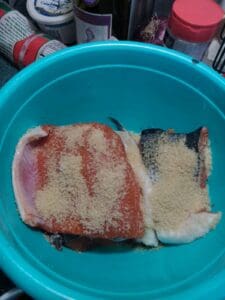
Brian and Ellen bought me a Big Chief smoker for Christmas. I’d used my home-built smoker to smoke salmon for canning, which is a bit easier to do than hot smoking, since all you’re trying to do is get a nice pellicle (outer sort of hard layer of skin on the flesh) and smoke flavor. You don’t want it to finish drying and smoking on the inside. The canning will finish the cooking process and then some.
Hot smoking is both the nice pellicle on the outside and cooked all the way through on the inside. It’s been a long time since I hot smoked salmon, and my past attempts were edible but not consistent, I’d say. Kevin makes great smoked king salmon in the same kind of smoker, so I asked him for advice. He uses a 2:1 brown sugar to salt dry brine, brines the fish 6 to 8 hours (or overnight), dries it for 8 hours till it’s shiny and tacky on the outside, then smokes it about 4 hours. Howard added advice to use a meat thermometer so you can take off pieces that are done while leaving thicker pieces until they are done.
Paul’s birthday (Feb 29—only happens every 4 years) and the day he passed away (Aug 1—opening day of deer season) are easy to remember. Smoking fish seemed like a good activity to remember him. So the night before his passing date, I started.
I didn’t have brown sugar, so used white sugar instead. I mostly had large king salmon steaks, as that’s how I like to cook king salmon. I thawed the fish in water in the sink and mixed the brine. I coated the first piece of fish with brine and put it in the bottom of a bowl. I coated the next pieces in the brine and layered them on or around the pieces below till all the fish was coated in the bowl. I left the fish in the brine overnight, monitoring as the brine became liquid, and moved pieces around so they stayed coated. I freshened the fish the next morning (i.e., rinsed it repeatedly in freshwater) to remove some of the salt so the product isn’t too salty. I hung the rack over the dehumidifier and in front of an open window for drying.
I called Tyler and Nevette on FaceTime or whatever it’s called, and Steve on the cell phone. All of us knew what today was and each was glad someone called to talk about Paul. We all miss him.
After about 6 hours of drying, the fish looked ready for the smoker.
I put the fish on the racks, with the thickest pieces on the bottom rack and the thinnest on the top rack. There are 5 racks, and I had 4 racks’ worth of fish, so I didn’t put anything on the lowest rack nearest the heat.
I used the alder wood shavings that came with the smoker for the first round of wood in the pan on the heating element, then used alder sticks I’ve gathered from our land and peeled for the next 3 batches of smoke.
I tested the thickest fish pieces at 4 hours, and the gauge showed 140 degrees—just about the 145-degree target. I left the fish another half hour and pulled it out. I cracked pieces on all racks, and it all was done. I transferred the fish to a pan to cool. I tried a few pieces. Perfect! Well, that was easy. I’ll have to learn better how to monitor with the meat thermometer so I don’t overcook some pieces, but none of these looked too dry. Now eager to try smoking some more fish, which will have to wait till we catch more. (Which I did, by the way. I used 4 cups brown sugar to 3 cups salt, and it was a little less sweet, which I liked).
Also my first time picking thimbleberries. In Juneau, it seemed there was just a few berries per plant. Here in Craig and in this particular area, they are coming on like crazy. Thimbleberries are good to eat, but there is not much to them. It takes a lot of picking to make a pile. I picked for 3 or 4 times around our place. There might be 10 berries on a bush, but only one or two are ripe. I had a tad over 4 cups of mashed berries. I added 3 cups of sugar and put the mash to boil in the instant pot. From what I’ve read, thimbleberries are loaded with pectin, so no additional pectin is needed. When the mash temp was between 200 and 220 degrees, I jarred the mash. It made 7 half pints, which exactly fit in the instant pot for a 10-minute boiling water bath can. It thickened up nicely. A lot of work for 7 half pints, and it looks lovely. When I tasted it, I determined it was worth it. Some of the best-tasting jam I’ve ever made. The thimbleberries have a hint of raspberry taste, but not the big seeds of raspberries or salmonberries. This instant pot gizmo is very versatile. The more I use it, the more I like it.



